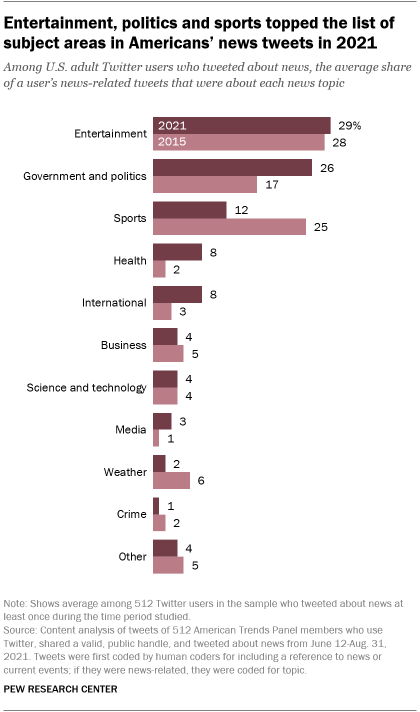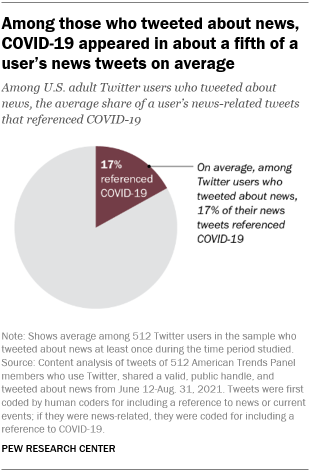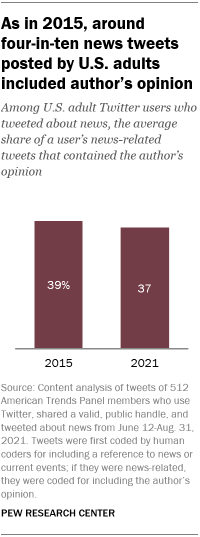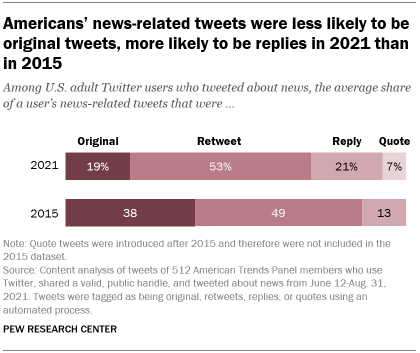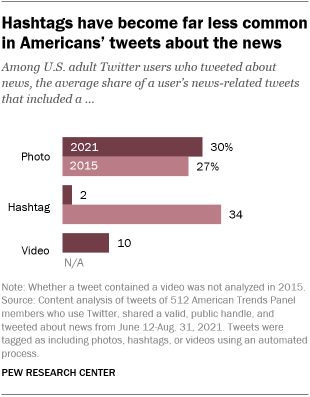Most Americans who use Twitter get news on the platform, according to a recent Pew Research Center survey. But how do these Americans engage with the news they see there?
To find out, the Center examined tweets from more than 500 U.S. adults who took part in the May 2021 survey, provided researchers with a valid, public Twitter handle and sent at least one news-related tweet between June 12 and Aug. 31, 2021. Researchers then grouped these Americans’ news tweets into major topic areas and examined other aspects of each tweet, such as whether it included the author’s personal opinion and whether it was an original tweet, a retweet, a reply or a quote tweet.
Below is a closer look at how the average adult Twitter user in the United States tweeted about the news during this time period, as well as how these patterns have changed since 2015, when the Center last conducted a similar study.
This analysis looks at news-related tweets from all users who tweeted at least once during the study period, regardless of whether they tweeted only a few times during that span or whether they tweeted more than 1,000 times. In other words, while other studies by the Center have shown that a small number of users produce the vast majority of tweets posted by U.S. adults, this analysis focuses on the behavior of the average user, regardless of their tweet frequency.
Of the U.S. Twitter users examined, 83% tweeted about news at least once during the 11-week period. And as is true of posting on Twitter in general, most of those who tweeted about news did so relatively infrequently – with 55% tweeting between one and nine times during the period studied.
For additional information about the methodology of this analysis, read the two drop-down boxes below.
Pew Research Center conducted this analysis to understand how adult Twitter users in the United States engage with the news in their own tweets on the platform.
For this analysis, we initially surveyed 2,548 U.S. adult Twitter users in May 2021. Everyone who took part in this survey is a member of the Center’s American Trends Panel (ATP) – an online survey panel that is recruited through national, random sampling of residential addresses – and indicated that they use Twitter. The survey also included 1,026 respondents who volunteered a valid Twitter handle (their unique user name preceded by an “@” sign) for research purposes. This allowed the Center to analyze their actual (observed) behaviors on the platform. Of these Twitter users, 620 tweeted publicly at least once, and 512 tweeted about news or current events at least once. The sample analyzed here comes from tweets produced by respondents with public accounts who tweeted from June 12 to Aug. 31, 2021.
In addition to automatically detecting the links, photos and videos included in the tweets, researchers hand-coded the content of these tweets to answer a few key questions: Was the tweet about current news? What were the topics of the tweets about news? Did the tweets reference the COVID-19 pandemic? Did users add personal opinions to their tweets about news? In many cases, the results from this analysis could be compared with those from a similar study in 2015.
This is the latest report in Pew Research Center’s ongoing investigation of the state of news, information and journalism in the digital age, a research program funded by The Pew Charitable Trusts, with generous support from the John S. and James L. Knight Foundation.
Here is the topline for this report and its methodology.
Instead of analyzing Twitter behavior at the tweet level, this analysis focuses on the typical user’s behavior on the platform. In other words, rather than examining the proportion of all tweets that are about the news, it looks at the proportion of an average user’s tweets that are about the news.
Say, for example, that one user tweeted 10 times, and three of those tweets – or 30% – were about the news. Another user tweeted 1,000 times, but only 100 of those tweets, or 10%, were about the news. This analysis treats all respondents equally, regardless of their total number of tweets, so we give the same weight to both of these percentages. Averaging these two values together (30% and 10%), we can say that between these two users, 20% of their tweets, on average, were about the news.
Americans who tweeted about the news in 2021 focused mostly on three subject areas: entertainment, politics and sports. These three subject areas were also the most common among Americans who tweeted about the news in 2015.
The average U.S. adult Twitter user focused on entertainment in 29% of their news-related tweets in 2021, which was roughly the same share as in 2015 (28%). But a much larger share of their news tweets focused on government and politics in 2021 than in 2015 (an average of 26%, up from 17%).
Sports, on the other hand, declined as a subject of Americans’ news tweets between 2015 and 2021. On average, 12% of users’ news tweets in 2021 were about sports, down from 25% in 2015. Some of these differences are likely attributable to the different timing of the studies: The 2015 tweets included the weeks surrounding the Super Bowl, and the 2021 study was conducted during the ongoing COVID-19 pandemic (though the shortened NBA finals still were played).
Tweets about health made up an average of 8% of Americans’ news tweets in 2021, up from just 2% in 2015. This increase, not surprisingly, may be related to COVID-19.
Americans occasionally mentioned the coronavirus pandemic in their news-related tweets in 2021. In 2021, the average American Twitter user mentioned the pandemic in some way in 17% of their news tweets, whether it was the virus itself, vaccines or related issues such as mask mandates or travel restrictions. (Since COVID-19 can cut across many different subject areas, references to the pandemic are examined separately in this analysis. Tweets with these references are also categorized into one of the broader topic areas above, with health and politics the most common groupings for news tweets that mentioned the coronavirus in some way.)
Americans included their personal opinions in around four-in-ten of their tweets about the news. An average of 37% of the news-related tweets posted by U.S. adults in 2021 included the author’s opinion, similar to the 39% share that did so in 2015. (In this analysis, retweets of opinionated tweets by someone else are not counted as including the author’s own opinion.)
When tweeting about the news in 2021, Americans posted fewer original tweets – and more replies – than in 2015. In 2015, an average of 38% of a user’s news-related tweets were original – that is, they were not replies or retweets. In 2021, however, this average fell to just 19% of the total.
Replies, on the other hand, increased between the two studies, from an average of 13% in 2015 to an average of 21% in 2021. (In this analysis, replies to one’s own tweets – often used to create “threads” – are counted as replies, not as original tweets.)
One change to Twitter that took place between the 2015 and 2021 studies – and which likely helps account for the decline in original tweets – was the introduction of quote tweets. This function allows a user to re-post a tweet while at the same time adding text above it. In 2021, an average of 7% of the Americans’ news-related tweets were quote tweets.
In a change since 2015, very few of Americans’ news-related tweets included a hashtag in 2021. In 2015, about a third of an average user’s news-related tweets (34%) contained a hashtag, but that share fell to an average of just 2% in 2021. Photos, on the other hand, remained about as common in 2021 as in 2015 (30% and 27%, respectively). And in a measure that wasn’t included in the 2015 study, an average of 10% of Americans’ news tweets included a video in the period studied in 2021.
Note: Galen Stocking provided assistance in data collection and analysis. Emma Goldstein, Jacob Liedke, Sarah Naseer and Emily Tomasik provided assistance in content coding.
Here is the topline for this report and its methodology.




